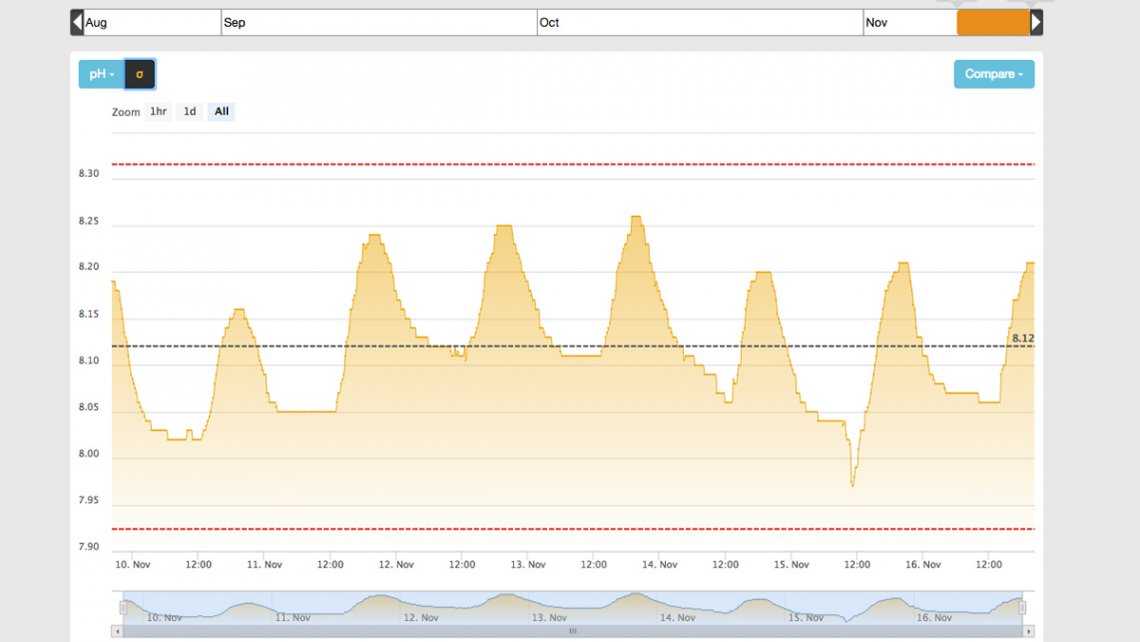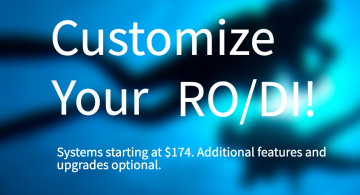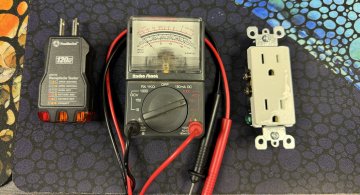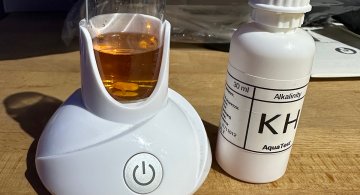Don't chase the pH
A question that has been popping up a lot recently has been in regards to pH levels. Articles, books and even additives list recommended pH levels so it is only natural to be concerned if our tank isn't sitting at that particular number. pH rises in oxygen rich environments, and where O2 is lacking or excessive CO2 builds up, pH will drop. In addition, pH rises daily during the lighting period, and drops during the night. Here's a graph from the past week's data stored in my Apex controller. Note how it rises and falls consistently day after day.
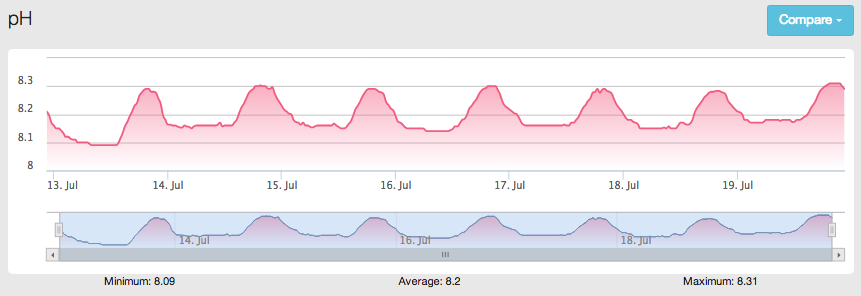
Here's the same graph highlighting the past 24 hours. By moving the mouse along the red line, I can see what the value was at any preferred point in time. At 05:23 a.m., it was measuring 8.17 (or nearly 8.2).
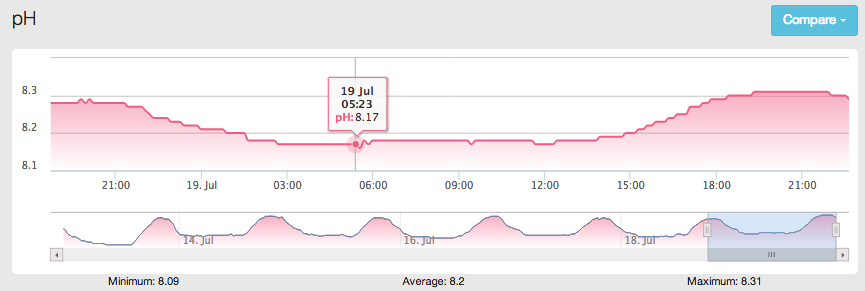
It's very normal for the pH to drop quite a bit during the late night hours. Photosynthesis isn't taking place, hence no new oxygen is being produced. The period from 4 a.m. to 7 a.m. could potentially be a crucial time because pH is usually at its lowest. Anywhere between 4 a.m. and 8 a.m. would be a good time to dose the Alkalinity portion of your daily additives (commonly referred to as 2-part dosing). When you dose Soda Ash (or Sodium carbonate), pH rises accordingly. The product is dosed to maintain a specific alkalinity level in the tank, and the rise in pH is an additional benefit, but it is not being dosed specifically to get pH to a certain level. It just happens in conjunction with dosing. And it's best to dose it when the pH is depressed in the tank.
Another way to raise pH during the late night hours is to run a refugium filled with Macro Algae on a reverse light cycle. Having the plants lighted from 11 p.m. to 8 a.m. would result in the benefit of oxygen being produced by the photosynthesis of the plants. They absorb some CO2 and produce O2. Running the reversed lighting cycle will help even out the pH swing, staving off an even larger dip.
When the tank lights come on, you'll observe how the pH begins to rise for the day. Usually within 5-6 hours it will hit a specific peak for the day, and then it will begin to drop off again. It's rising because of the aquarium lighting assisting with the in-tank photosynthesis, in part from the symbiotic algae within the corals.
During the evening, this would be a good time to dose the Calcium portion of the 2-part dosing. Basically dosing Calcium about 12 hours later prevents precipitation. Both Part A and Part B (or Part 1 & Part 2; or Alkalinity & Calcium) should be dosed in an area of high flow so it mixes into the water column. It should trickle in slowly, not be dumped in all at once. A peristaltic doser is a nice way to take care of this task, setting it with a timer to run quietly each day at a specified time or times. Finally, Magnesium can be dosed any time of day. It takes a lot of Magnesium to raise the level in the tank if it is depleted, but once you attain the target level, it tends to stay there for a long time.
Water temperature can affect pH if it gets too warm. When a tank reaches 85° F, oxygen levels plummet and with those the pH would drop off significantly.
Now that you've been told all of the above, what's my point? People that chase pH often dose their tank much too much with a buffer that will raise the alkalinity levels too high. They keep measuring pH and when they see it is "low" they add more powdered solution to get that number up because they are worried about hitting a magic number. When it comes to measuring pH, the best method is a pH meter. I don't recommend the pH test strips because they will become inaccurate over time (each time you open the jar to take a strip out, oxygen gets in and degrades the test strips which is why the instructions always say to close the lid tightly). American Pinpoint has a very nice battery powered pH meter that is easy to calibrate and can be used from tank to tank as well as to measure the pH of newly mixed saltwater prior to a water change. It can be used to measure the pH of new fish arrivals still in the bag of water too. If you own a controller like the Apex or Reefkeeper, it comes with a pH probe. That probe comes with a rubber cap that needs to be removed when you install it in the sump or tank. The tip remains submerged in the system and the readings are constantly available on a digital display, or can be checked in a browser or smartphone. Knowing the pH of the tank at a glance is great, but knowing what is the normal pH level for your tank on a day to day basis is even more important.
If you keep your reef's water parameters at normal levels equal to natural sea water, pH should take care of itself. Here are the target numbers:
- Temperature: 77-79° F -- If your tank runs 79-81° daily, that's okay. If your tank runs 72-84° daily, you have bigger problems to deal with. 1° or 2° changes per day are within acceptable limits.
- Salinity: 1.026 sg or 35 ppt -- use a calibrated refractometer. Calibrate it with 35 ppt calibration solution; never use RO/DI water to calibrate it because it will skew the results.
- Alkalinity: 8-11 dKH -- this is the target zone. It should be somewhere within that range, and stay quite stable with regular alkalinity dosing. 8-8.5 dKH is perfectly fine (and this level is best for biopellet users)
- Calcium: 375-425 ppm -- through regular calcium dosing, this number should stay pretty much where you need it to be. It shouldn't waver much; it will commonly test about the same week after week.
- Magnesium: 1380 ppm -- that number is my preference, especially if you keep Montipora in your system. Magnesium should be three times the calcium level (Calcium = 440 x 3 = 1320 ppm Magnesium). I prefer to keep it closer to 1400 ppm in my tanks, and that yields colorful montipora colonies.
If those five measurements are within range, pH will be whatever it will be. Yes, you can pump in fresh air from outside and run it to your skimmer. Yes, you can dose kalkwasser during the night to help raise it. Yes, you can add pH buffers to raise the number, but why? There are some beautiful reefs out there that seem to thrive in a daily pH swing of 7.7 to 7.9 for years at a time.
If the pH level seems crazy wrong, get the instructions out and calibrate your pH probe with the appropriate solutions. And even more importantly, observe the livestock. How are the fish and corals doing? Are the corals growing steadily? Are the fish swimming naturally and eating normally? Is coralline growing on the glass, pumps and rock? If all is well, it's best not to mess with success just because you are seeking to hit a target number. It's normal for the pH to measure lower during the months we seal up our homes to keep the heat of summer or the cold of winter outside where it belongs.

Happy reefing.
